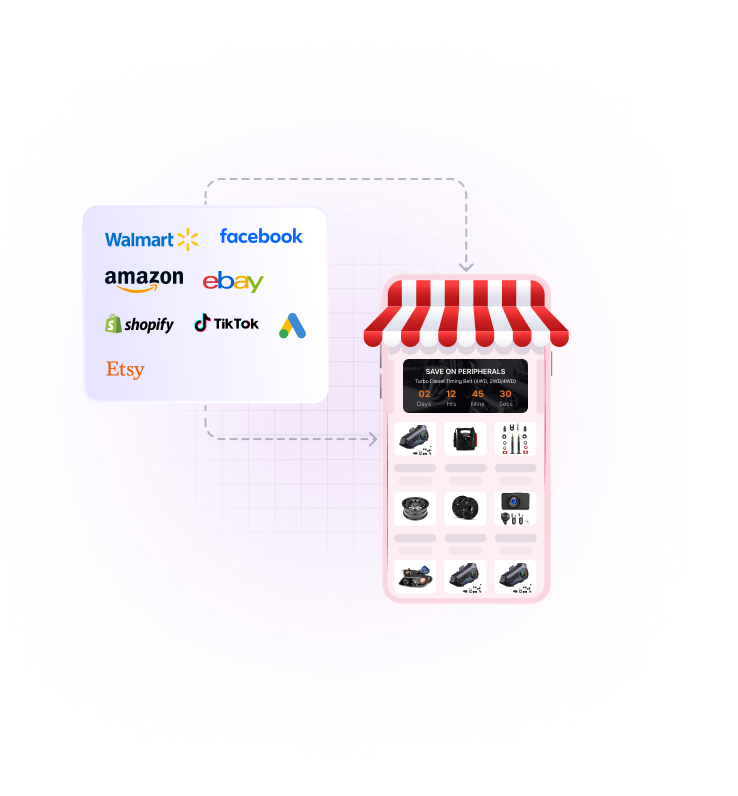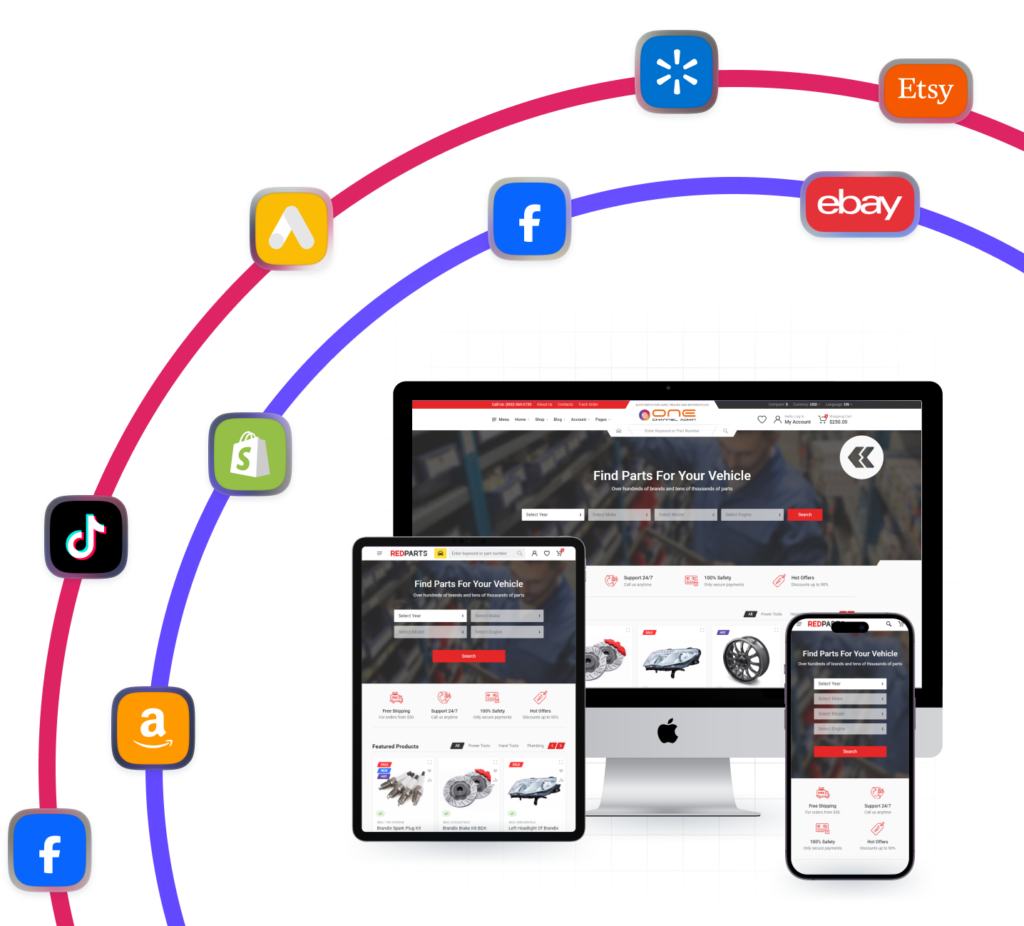A comprehensive platform for seamless aggregation and efficient management of all your feeds
Optimize product data accuracy, consistency, and performance across all channels and platforms for maximum impact.
Create a unified data structure to streamline product and inventory feeds for enhanced efficiency and compatibility

Elevating Data Quality and Reliability:
By adhering to a standardized format, businesses can significantly enhance the accuracy and consistency of product data. This approach ensures that data across various channels and platforms is uniform and reliable, leading to a higher overall quality of information. This consistency is critical for making informed decisions and maintaining a trustworthy presence in the marketplace.
Maximizing Resource Efficiency:
A standardized data structure eliminates the need for manual reformatting of product data, allowing e-commerce businesses to save time and resources. This streamlined process ensures that product information is readily compatible with diverse channels and platforms, freeing up valuable resources that can be redirected towards growth-focused activities.
Enhancing Cross-Channel Visibility:
With a unified data structure, e-commerce businesses can optimize product data for different channels and platforms, significantly improving visibility and performance across all marketing avenues. This comprehensive optimization leads to better alignment of product information with the unique requirements of each channel, enhancing overall market penetration and engagement.
Driving Operational Efficiency:
Standardized data structures simplify the management of product and inventory feeds by providing a common format that integrates effortlessly with multiple platforms. This reduces the need for manual data entry, minimizes errors, and accelerates the process of uploading and updating product and inventory details, resulting in increased operational efficiency.
Facilitating Seamless Integration:
By adopting a standardized data approach, businesses can seamlessly integrate with various marketplaces, marketing channels, and platforms. This broad integration capability makes it easier to reach a wider audience, boost sales, and manage product and inventory information efficiently across multiple platforms, ultimately saving time and resources while enhancing market reach and customer engagement.
Unlock the power of optimized and enhanced data feeds for superior performance and growth
Boosting Product Visibility and Differentiation:
Leveraging high-quality images, videos, and detailed product descriptions across multiple channels and platforms enhances product listings, helping them stand out from competitors. This increased visibility ensures that products capture customer attention, fostering brand recognition and differentiating offerings in a crowded marketplace.
Driving Conversions with Engaging Content:
Providing comprehensive and engaging product information significantly increases the likelihood of conversion. By offering rich content—such as detailed descriptions, feature lists, and visual assets—businesses can effectively communicate product value, build trust, and encourage customers to make informed purchasing decisions, ultimately boosting sales.
Dynamic Pricing for Optimized Profitability:
Enhanced data feeds enable real-time pricing adjustments based on market demand and supply fluctuations. This dynamic pricing strategy allows businesses to optimize their pricing to remain competitive, maximize profitability, and respond swiftly to market changes, ensuring sustained growth in revenue.
Improving SEO for Greater Organic Reach:
Optimized and structured data feeds improve search engine visibility by aligning product information with SEO best practices. This increases the likelihood that products will rank higher on search engine results pages (SERPs), driving more organic traffic and enhancing brand exposure, leading to a potential increase in sales and market share.
Enhancing Customer Experience for Loyalty and Retention:
A rich, detailed view of products—featuring comprehensive information and visuals—empowers customers to make informed decisions, fostering a more positive shopping experience. This not only enhances customer satisfaction but also builds loyalty, encouraging repeat purchases and long-term customer retention.
Gaining a Competitive Advantage in Marketplaces:
Marketplace-specific optimization allows businesses to tailor their product listings to meet the unique requirements and preferences of each platform. This focused strategy provides a competitive edge over other sellers, improving visibility, engagement, and sales performance within targeted marketplaces.
Achieving Cost-Effectiveness Through Targeted Campaigns:
By optimizing product and advertising campaigns for specific marketplaces, businesses can achieve higher returns on investment with less expenditure. A targeted approach allows for more efficient allocation of marketing budgets, reducing waste and enhancing the effectiveness of promotional efforts.
Elevating Search Rankings Within Marketplaces:
Targeted optimization of product listings and advertising efforts enhances search rankings within specific marketplaces, making it easier for customers to discover products. This improved positioning leads to greater visibility, increased traffic, and higher conversion rates, driving growth and market success.

Streamline and optimize your product feed management with powerful, ready-to-use templates for maximum efficiency and accuracy

Streamlined Data Management for Enhanced Accuracy and Consistency:
Feed management templates offer a pre-defined structure for organizing product and inventory data, greatly reducing the manual effort and time required to create and manage data feeds. By automating the data organization process, these templates ensure that information is consistently accurate, up-to-date, and aligned across all platforms, minimizing discrepancies and maintaining uniformity. This seamless data management process helps businesses avoid costly errors, ensuring a reliable flow of information that supports operational efficiency and enhances decision-making.
Elevated Data Quality and Trustworthiness:
By providing a standardized format for data entry, feed management templates significantly reduce the risk of errors and inconsistencies in product and inventory data. This structure is crucial for maintaining high-quality data that enhances customer trust and satisfaction. Reliable data not only supports more accurate product listings but also strengthens the brand’s reputation by ensuring that customers receive the correct information every time, leading to better customer experiences and loyalty.
Rapid and Effortless Integration Across Multiple Platforms:
Feed management templates are designed to be compatible with various marketplaces, marketing channels, and platforms, enabling faster and smoother integration. This compatibility reduces the complexity and time required to manage product and inventory data across multiple channels, allowing businesses to quickly adapt to new sales opportunities and market demands. The ability to seamlessly integrate data feeds enhances cross-platform visibility, helping businesses reach a broader audience more efficiently.
Tailored Customization for Specific Business Needs:
Feed management templates offer flexibility to be customized according to specific business requirements, such as adding or removing data fields, altering data formats, and more. This adaptability allows businesses to create data feeds that cater precisely to their unique needs and market conditions, providing the ability to optimize their product listings for specific channels or audiences. Customized templates empower businesses to be more responsive to changing market dynamics, enhancing their ability to compete and succeed.
Boosted Efficiency Through Automation:
Automating the creation and management of data feeds through standardized templates saves significant time and resources, freeing up valuable human capital to focus on other core activities such as sales, marketing, and customer service. This automation reduces the risk of manual errors, speeds up processes, and lowers operational costs. By streamlining these critical tasks, businesses can enhance productivity, improve resource allocation, and ultimately drive growth and profitability.
Overall, feed management templates offer a comprehensive solution that streamlines data management, improves data quality, accelerates integration, provides customization options, and boosts operational efficiency, empowering businesses to thrive in a competitive marketplace.
Revolutionize your data operations with automated feed management, ensuring real-time accuracy, efficiency, and seamless integration across all platforms
Minimized Manual Labor for Enhanced Productivity:
Automated feed management drastically reduces the need for manual data entry and management, saving significant time and resources. By automating these routine tasks, businesses can redirect their focus to more strategic activities, such as developing growth strategies and enhancing customer engagement. This shift not only boosts productivity but also streamlines operations, enabling teams to work more efficiently and effectively.
Elevated Data Quality and Consistency:
Automated feed management systems enhance data quality by minimizing the risk of errors and inconsistencies in product and inventory data. By ensuring that data is accurate, up-to-date, and consistently formatted across various platforms, businesses can maintain high standards of data integrity. This reliable data foundation helps to build customer trust and supports better decision-making, ultimately leading to improved operational performance.
Accelerated Integration Across Channels:
Automated feed management simplifies the integration of product and inventory data with diverse marketplaces, marketing channels, and other platforms. This streamlined process reduces the time and effort required to synchronize data across multiple channels, facilitating quicker market entry and more responsive adjustments to market conditions. The efficiency gained from faster integration enables businesses to capitalize on opportunities and maintain a competitive edge.
Real-Time Data Updates for Improved Operations:
Real-time updates to product and inventory data through automated feed management ensure that information is always accurate and current. This capability helps to prevent stockouts and overselling, thereby enhancing customer satisfaction and operational reliability. Timely data updates support more effective inventory management and pricing adjustments, contributing to smoother business operations and a better customer experience.
Enhanced Efficiency Through Automation:
Automated feed management optimizes routine tasks such as updating inventory levels, adjusting pricing, and modifying product descriptions. This automation not only increases overall efficiency but also allows businesses to allocate more resources to strategic initiatives like refining pricing strategies and improving product listings. By automating these processes, businesses can achieve higher levels of efficiency and focus on activities that drive growth and competitiveness.Overall, automated feed management transforms data operations by reducing manual labor, improving data quality, accelerating integration, providing real-time updates, and enhancing overall efficiency. This comprehensive approach enables businesses to streamline their operations, enhance accuracy, and focus on strategic growth initiatives.

Harness the power of feed management software with built-in business rules to streamline operations, ensure compliance, and drive strategic efficiency across all data channels

Tailored Data Management with Business Rules:
Customized data management through business rules allows businesses to establish specific guidelines for organizing and managing product and inventory data, ensuring that data handling aligns perfectly with unique business needs and operational requirements. This approach guarantees that data is structured and managed in the most effective way, enhancing overall efficiency and relevance.
Dynamic Pricing for Maximum Profitability:
Business rules enable dynamic pricing by setting parameters that adjust product and inventory prices based on real-time data and market conditions. This capability allows businesses to optimize pricing strategies, maximize profitability, and stay competitive by responding swiftly to market fluctuations and demand changes.
Enhanced Policy Compliance:
By incorporating business rules into feed management, businesses can establish guidelines for adhering to marketplace and channel policies. This ensures compliance with various platform requirements, significantly reducing the risk of policy violations and associated penalties, while maintaining smooth operations across multiple sales channels.
Improved Pricing Strategies:
Business rules facilitate the development of sophisticated pricing strategies by providing real-time data and insights on product and inventory performance. This enables businesses to refine pricing models, enhance product listings, and uncover new growth opportunities, leading to more effective pricing strategies and increased revenue.
Accurate Inventory Management:
With business rules, businesses can manage inventory levels with greater precision by setting rules for updates based on real-time data and market conditions. This reduces the risk of overselling or stockouts, ensuring that customers consistently have access to the products they need, and enhancing overall inventory management effectiveness.
Optimized Operations for Better Customer Experience:
Utilizing business rules to manage pricing strategies, inventory levels, and compliance ensures a more streamlined and responsive operation. This approach saves time, increases control and flexibility, and enables real-time policy updates, ultimately providing a better customer experience and driving growth through optimized operations.
